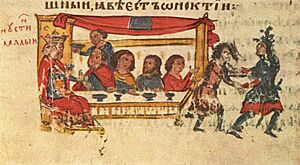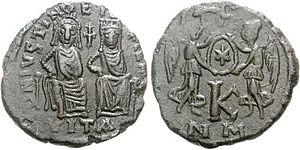Justin II facts for kids
Quick facts for kids Justin II |
|||||
|---|---|---|---|---|---|

Solidus of Justin II
|
|||||
| Byzantine emperor | |||||
| Reign | 14 November 565 – 5 October 578 |
||||
| Predecessor | Justinian I | ||||
| Successor | Tiberius II | ||||
| Born | Constantinople (now Istanbul, Turkey) |
||||
| Died | 5 October 578 Constantinople |
||||
| Spouse | Sophia | ||||
| Issue | Arabia Tiberius II (adoptive) |
||||
|
|||||
| Dynasty | Justinian dynasty | ||||
| Father | Dulcidio (or Dulcissimus) | ||||
| Mother | Vigilantia | ||||
| Religion | Chalcedonian Christianity | ||||
Justin II (Latin: Justinus; Greek: Ἰουστῖνος, translit. Ioustînos; died 5 October 578) was the Byzantine Emperor from 565 to 578. He was the nephew of Emperor Justinian I and married Sophia, who was the niece of Empress Theodora. This made him part of the important Justinian dynasty.
Justin II became emperor of a very large empire. However, it was also stretched thin and had fewer resources than when Justinian I ruled. Even so, Justin II wanted to be as famous as his uncle. He decided to stop paying money to neighboring groups to keep the peace. This risky decision led to new wars with the Sassanid Empire (Persians). It also caused the Lombards to invade, and the Romans lost a lot of their land in Italy.
Family and Early Life
Justin II was the son of Vigilantia and Dulcidio (also called Dulcissimus). Vigilantia was the sister of Emperor Justinian I. Justin had a brother named Marcellus and a sister named Praejecta.
With his wife Sophia, he had a daughter named Arabia. They might have also had a son named Justus, who died when he was young. Justin also had a niece named Helena.
Becoming Emperor
How Justin II Took the Throne
Emperor Justinian I passed away on November 14, 565, without any children. Callinicus, a high-ranking palace official, said he was the only one there when Justinian died. He claimed Justinian chose "Justin, Vigilantia's son" to be the next emperor. This was important because there was another nephew named Justin who could have also become emperor.
Some historians believe Callinicus might have made up Justinian's last words. They think he did this to help his friend Justin become emperor. As historian Robert Browning said, "Did Justinian really make a choice, or did Callinicus make it for him? Only Callinicus knew."
After Justinian's death, Callinicus told important members of the Byzantine Senate. Together, they offered the throne to Justin and his mother, Vigilantia. Justin agreed after pretending to be unsure for a moment. He and his wife Sophia were then taken to the Great Palace of Constantinople.
During the night, palace guards blocked the entrances. Early the next morning, John Scholasticus, the leader of the church in Constantinople, crowned Justin as the new Augustus (Emperor). Only then was Justinian's death and Justin's new rule announced to everyone in the Hippodrome of Constantinople.
Justin had helped both the church leader and Tiberius (the guard commander) get their jobs. So, it was not surprising that they helped him become emperor.
First Actions as Emperor
In his first few days as emperor, Justin II paid off his uncle's old debts. He also made sure justice was served fairly and announced that people could practice any religion they chose. On January 1, 566, he became a Roman consul, bringing back a position that Justinian had stopped using since 541.
Justin and Sophia first promised to make peace with Justin's cousin, also named Justin, who was a rival for the throne. However, they had him removed in Alexandria not long after.
In 566, Justin also changed Justinian's divorce law. He made it so that couples could no longer get divorced just by agreeing to it.
Foreign Policy Challenges
Dealing with Neighbors
Justin II faced an empty treasury, meaning the empire had little money. Because of this, he stopped Justinian's practice of paying money to potential enemies to keep them peaceful. Right after he became emperor, Justin stopped paying the Avars. This ended a peace agreement that had been in place since 558.
This decision upset the balance of power in the region. The Avars had to find new ways to get wealth to keep their power. The Avars and another group called the Lombards teamed up to defeat the Gepids. Justin had gained a fortress called Sirmium from the Gepids.
After this, the Avars put pressure on the Lombards, causing them to move west. In 568, the Lombards invaded Italy under their king Alboin. They quickly took over the Po valley and, within a few years, controlled almost the entire country.
The Avars themselves crossed the Danube River in 573 or 574. This happened when the empire was busy with problems on the Persian border. Justin's successor, Tiberius, later had to pay the Avars 60,000 silver coins to make them peaceful.
Wars with Persia
The northern and eastern borders were the main focus for Justin II. In 572, he refused to pay money to the Persians. He also tried to make friends with the Turks. These actions led to a war with the Sassanid Empire.
After two very bad campaigns, the Persians, led by Khosrow I, took over Syria. They also captured the very important fortress of Dara. After these losses, Justin II became very ill and started to lose his mind.
Silk Trade and Alliances
Around this time, silkworm eggs were secretly brought into the Byzantine Empire from China. A historian named Menander Protector wrote about how the Sogdians tried to trade Chinese silk directly with the Byzantine Empire.
After working with the Sassanid ruler Khosrow I to defeat another empire, Istämi, the ruler of the Western Turks, was asked by Sogdian merchants for permission to travel through Persian lands to trade with the Byzantines. Istämi first said no. But when he allowed a second group of Sogdian traders to go to the Persian king, the king had them poisoned.
A Sogdian diplomat named Maniah convinced Istämi to send a group directly to Constantinople. This group arrived in 568. They brought silk as a gift for Justin and suggested an alliance against Sassanid Persia. Justin agreed and sent his own group to the Turkic Khaganate. This helped the Sogdians get the direct silk trade they wanted.
In 1937, a historian named Previte-Orton described Justin as "a rigid man, dazzled by his predecessor's glories, to whom fell the task of guiding an exhausted, ill-defended Empire through a crisis of the first magnitude and a new movement of peoples."
Succession and Death
After 572, it was reported that Justin II had periods of mental illness. A writer named John of Ephesus described Justin's madness. He said Justin sometimes acted like a wild animal, had to be moved around on a special chair, and needed organ music played constantly.
In 574, his wife Sophia suggested that he adopt the general Tiberius as his son and heir. Justin then stepped back from ruling in Tiberius's favor.
Four years later, on September 26, 578, Justin made Tiberius a full Augustus (Emperor). Justin II died just nine days later, on October 5, 578.
Images for kids
See also
 In Spanish: Justino II para niños
In Spanish: Justino II para niños









